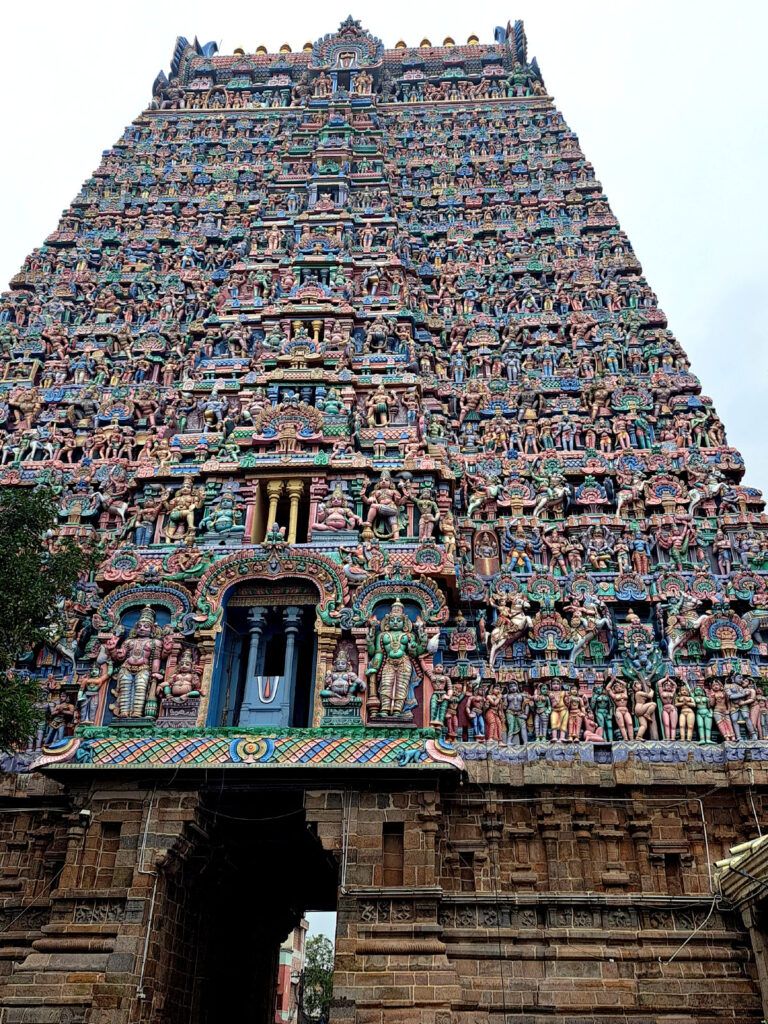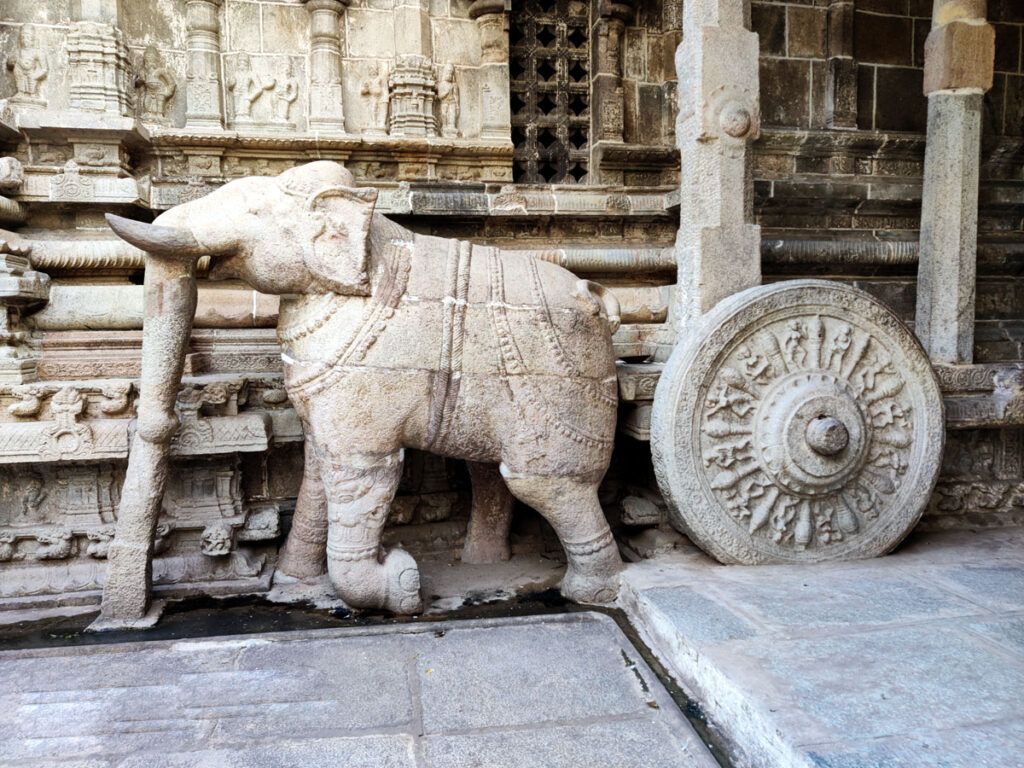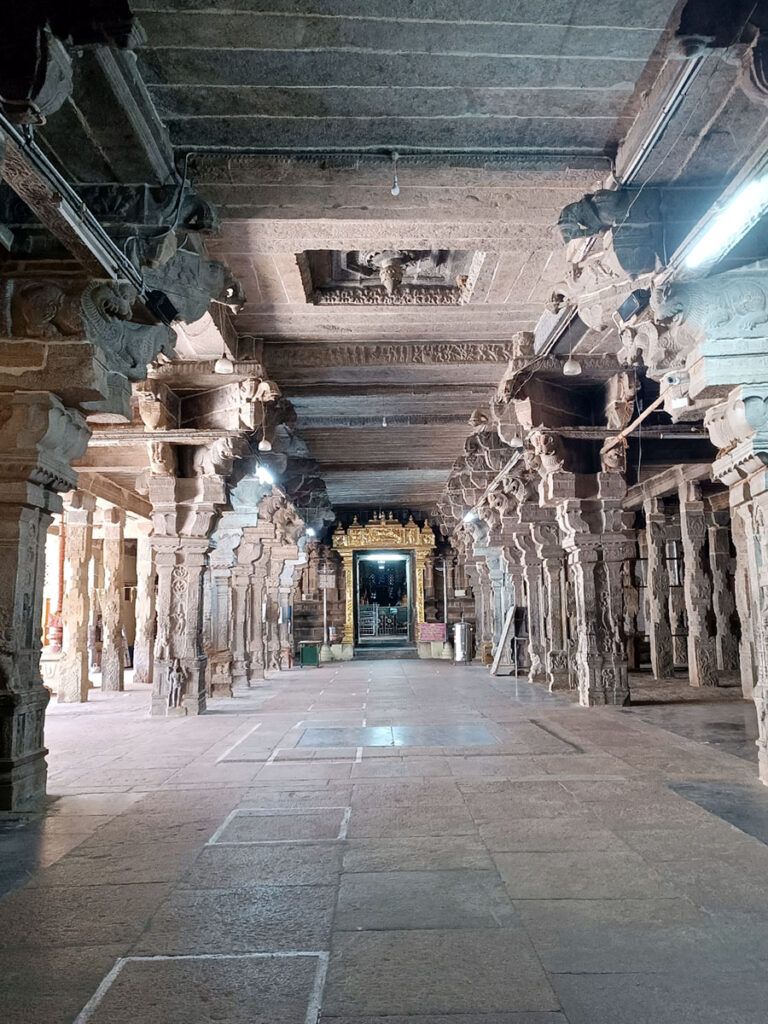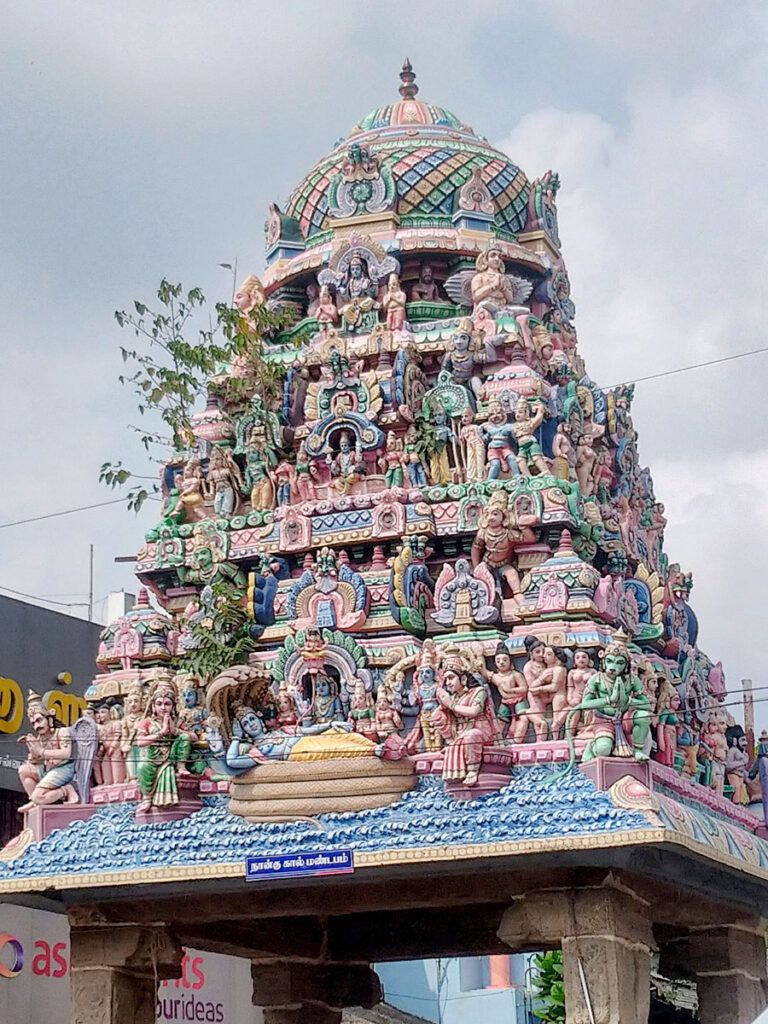6th CE Sarangapani Temple Kumbakonam
The Sarangapani Temple is a majestic Hindu temple dedicated to Lord Vishnu, situated in the bustling town of Kumbakonam in Tamil Nadu, India. Renowned as one of the 108 Divya Desams, which are sacred abodes of Vishnu revered by the 12 poet saints, or Alvars, the Sarangapani Temple stands as a testament to the rich spiritual heritage of India.

Sanskrit Sloka:
स रंगपणिर् भगवान् वरदः सर्वतोऽपि
रङ्गस्थानीयं दिव्यं हरिदर्शनम्
कौशिक्यां विहाय वैकुण्ठं जगदीश्वरः
कौशिक्यां विराजमानः करुणावीर्यः।।
Meaning:
Lord Sarangapani, the giver of boons to all, The divine vision of Hari in the Rangasthanam, Leaving Vaikuntha, the Lord of the universe, Resides in Kumbakonam, compassionate and heroic.
The sloka describes Lord Sarangapani as the giver of boons to all, and the divine vision of Hari in the Rangasthanam. It also says that the Lord of the universe, leaving Vaikuntha, resides in Kumbakonam, compassionate and heroic.
Contents
- 1 History of Sarangapani Temple Kumbakonam:
- 2 Legend of Sarangapani Temple Kumbakonam:
- 3 Architectural Splendor of Sarangapani Temple:
- 4 Sarangapani Temple Kumbakonam Timing:
- 5 Places to visit near Sarangapani Temple Kumbakonam:
- 6 FAQ:
- 6.0.1 What is the Sarangapani Temple?
- 6.0.2 What is the significance of the Sarangapani Temple?
- 6.0.3 What are the main features of the Sarangapani Temple?
- 6.0.4 What are the temple rituals?
- 6.0.5 How to get to the Sarangapani Temple?
- 6.0.6 Timings and Entry fees
- 6.0.7 What is the meaning of Sarangapani?
- 6.0.8 Why is Vishnu called Sarangapani?
- 6.0.9 When was the Sarangapani Temple built?
- 7 How to reach Sarangapani Temple Kumbakonam:
- 8 Google Maps:
History of Sarangapani Temple Kumbakonam:
Legendary Origins
According to one legend, the temple’s origins can be traced back to the devotion of Sage Hemarishi, who performed intense penance on the banks of the Potramarai tank. His fervent prayers invoked the appearance of Sarangapani, who revealed himself in the form of a bow, hence the name “Sarangapani” or “the bearer of the bow.”
Another legend narrates the story of Lakshmi Devi, the consort of Lord Vishnu, who was born from a thousand-petaled lotus flower in the ocean of milk. She was discovered by Sage Hemarishi, who raised her as his own daughter. Lakshmi Devi ultimately married Sarangapani, cementing the temple’s sanctity and importance.
Historical Evidence
While the exact date of the temple’s construction is unknown, historical evidence suggests that it dates back to the Pallava period (6th to 9th centuries CE). Inscriptions found within the temple walls indicate that various rulers, including the Cholas, Vijayanagara Empire, and Madurai Nayaks, made contributions to its expansion and renovations throughout the centuries.

Legend of Sarangapani Temple Kumbakonam:
The Origin of Sarangapani
Long ago, a sage named Hema Rishi, renowned for his piety and devotion to Lord Vishnu, embarked on rigorous penance on the banks of the Potramarai tank, a sacred waterbody in Kumbakonam. His unwavering devotion caught the attention of Lord Vishnu, who decided to bless the sage with a divine gift.
The Birth of Komalavalli
As Hema Rishi continued his intense penance, a magnificent lotus flower bloomed amidst the tranquil waters of the tank. From the heart of this lotus, a beautiful maiden emerged, radiating an ethereal glow. This enchanting maiden was none other than Goddess Lakshmi, the consort of Lord Vishnu, who had descended to earth in human form, responding to the sage’s fervent prayers.
Lord Vishnu, pleased with Hema Rishi’s dedication, bestowed the maiden with divine powers and named her Komalavalli, meaning “one who emerged from a lotus.” Hema Rishi, overwhelmed with joy, raised Komalavalli as his daughter, showering her with love and affection.
The Arrival of Sarangapani
One day, as Hema Rishi and Komalavalli were strolling along the banks of the Potramarai tank, a magnificent chariot, drawn by horses and elephants, descended from the heavens. Emerging from the chariot was Lord Vishnu himself, adorned with his divine attributes and carrying his signature weapon, the Saranga bow.
Lord Vishnu had arrived to marry Komalavalli, uniting the supreme deity with his divine consort in human form. The celestial event sparked joyous celebrations throughout the region, and the divine couple resided in the town, bringing prosperity and harmony to its inhabitants.
The Sarangapani Temple
To honor the divine marriage and commemorate the blessings bestowed upon Hema Rishi, a temple dedicated to Lord Sarangapani, meaning “one who holds the bow,” was constructed on the banks of the Potramarai tank. The temple has since become a revered pilgrimage destination, attracting devotees from across the country seeking divine blessings.
The Deity of Sarangapani
The central shrine of the temple enshrines the majestic statue of Lord Sarangapani, standing gracefully in a standing posture. He holds his signature Saranga bow and the Sudarshana Chakra, his divine discus, symbolizing his role as the protector and preserver of the universe.
The Temple’s Significance
The Sarangapani Temple holds immense spiritual significance for devotees, who believe that Lord Sarangapani grants blessings of happiness, prosperity, and marital bliss. The temple’s annual festivals, particularly the Chariot Festival, draw massive crowds, creating a vibrant spectacle of devotion and celebration.
The Enduring Legend
The legend of Sarangapani and Komalavalli continues to captivate the hearts of devotees, weaving a tale of divine love, unwavering devotion, and the blessings bestowed upon those who seek them with sincerity. The Sarangapani Temple stands as a living monument to this enchanting legend, a testament to the enduring power of faith and the divine love that binds the universe together.

Architectural Splendor of Sarangapani Temple:
- Rajagopuram (Main Tower): The temple has a majestic rajagopuram, which is the main tower at the entrance. This tower is adorned with intricate sculptures and carvings depicting various mythological stories.
- Prakara (Enclosure): Like many South Indian temples, Sarangapani Temple has a large prakara or enclosure that surrounds the main sanctum and other smaller shrines within the temple complex.
- Main Sanctum (Garbhagriha): The main deity of the temple is Lord Sarangapani (a form of Lord Vishnu), and the sanctum sanctorum houses the principal deity. The idol of Lord Sarangapani is in a reclining posture on the serpent Adisesha.
- Mandapas (Halls): The temple complex includes various mandapas or halls, such as the Ardha Mandapa and the Maha Mandapa. These halls are used for conducting religious ceremonies, and they often feature ornate pillars and sculptures.
- Vimana (Tower above Sanctum): The vimana is the tower above the sanctum sanctorum. It is typically pyramidal and decorated with intricate carvings and sculptures.
- Tank (Theertham): The temple has a sacred tank called Chakkara Theertham. The presence of a tank is a common feature in South Indian temples and adds to the overall aesthetics of the temple complex.
- Sculptures and Carvings: The temple is renowned for its exquisite sculptures and carvings that depict various scenes from Hindu mythology. These intricate carvings can be found on the walls of the temple, pillars, and other structures.
- Gopurams (Entrance Towers): Apart from the main rajagopuram, there may be smaller gopurams at various entrances to the temple complex, each with its own unique design and sculptures.
- Hall of Music: One distinctive feature of the Sarangapani Temple is the “Hall of Music” or “Saptaswara Mandapa,” where musical pillars produce different musical notes when struck.

Sacred Rituals and Traditions
The Sarangapani Temple is renowned for its adherence to ancient rituals and traditions, upholding the devotional practices that have enriched the Hindu faith for centuries. The temple’s daily schedule is marked by a series of pujas (worship ceremonies) conducted with meticulous precision, each offering a unique opportunity for devotees to seek blessings and spiritual solace.
Within the temple complex, the Navagraha Mandapam stands out as a captivating astronomical marvel. This shrine houses nine shrines dedicated to the nine celestial bodies, believed to influence human destinies. Devotees often visit this shrine to seek divine blessings and guidance related to their horoscopes and life paths.
Serene Pond and Sacred Nectar
The temple’s serene Potramarai tank, believed to be the source of the divine nectar that empowered Sarangapani, holds immense spiritual significance. Devotees often immerse themselves in the tank’s waters seeking purification and spiritual rejuvenation.
Prestigious Divya Desam and Pilgrimage Site
The Sarangapani Temple is revered as one of the 108 Divya Desams, the sacred shrines mentioned in the Nalayira Divya Prabandham, a collection of devotional Tamil hymns composed by 12 revered Vaishnava saints, known as the Alwars. This recognition further elevates the temple’s spiritual stature and attracts pilgrims from across India and beyond.
Enduring Reverence and Cultural Significance
The Sarangapani Temple stands as a enduring testament to the unwavering faith and devotion that have shaped the cultural landscape of India. Its rich history, architectural splendor, sacred rituals, and spiritual significance continue to attract devotees and inspire pilgrims seeking solace and spiritual enlightenment. The temple’s legacy is deeply woven into the fabric of Hindu tradition, ensuring its enduring presence as a beacon of spiritual devotion and cultural heritage.

Sarangapani Temple Kumbakonam Timing:
Morning:
- 6:00 AM – 7:00 AM: Utsavabali, daily rituals for the presiding deity, Lord Sarangapani
- 7:00 AM – 10:00 AM: Suprabhatha Archana, early morning prayers
- 10:00 AM – 12:00 PM: Uchikalam, the most important puja of the day, dedicated to Lord Vishnu
- 12:00 PM – 12:30 PM: Lunch break for temple personnel
Afternoon:
- 12:30 PM – 1:00 PM: Lunch Darshan, open for devotees who wish to have lunch at the temple
- 1:00 PM – 4:00 PM: Madhyahnam, the afternoon session of worship
Evening:
- 4:00 PM – 6:00 PM: Aarathi, the closing ritual of the day, with a procession of the deity around the temple
- 6:00 PM – 7:00 PM: Nithya Santhanam, a special puja dedicated to Lord Vishnu
- 7:00 PM – 9:30 PM: Evening Darshan, open for devotees to offer prayers and seek blessings from Lord Vishnu

Places to visit near Sarangapani Temple Kumbakonam:
Mahamaham Tank: This is a large temple tank located in Kumbakonam. It is believed that taking a dip in the Mahamaham Tank during the Mahamaham festival, which occurs once in 12 years, is considered auspicious.
Kasi Viswanathar Temple: This temple is dedicated to Lord Shiva and is known for its architectural beauty. It is located in the heart of Kumbakonam and is a popular pilgrimage site.
Adi Kumbeswarar Temple: Another significant Shiva temple in Kumbakonam, this temple is dedicated to Lord Kumbeswarar. It is one of the oldest temples in the town.
Sri Nageswaran Temple: This is a prominent temple dedicated to Lord Shiva. The architecture of the temple is noteworthy, and it is known for its intricate carvings.
Sarangapani Temple Car Festival: Depending on the time of your visit, you might be able to witness the grand car festival of Sarangapani Temple. It is a colorful and lively event that attracts devotees and tourists alike.
Chakrapani Temple: This temple is dedicated to Lord Vishnu in his form as Chakrapani. The presiding deity is depicted holding a discus (chakra), and the temple is known for its religious significance.
Uppiliappan Temple: Also known as Thoopul Vilakoli Perumal Temple, this is a Vishnu temple located near Kumbakonam. The temple is dedicated to Lord Vishnu and is known for its beautiful architecture.
Airavatesvara Temple: Located in Darasuram, a small town near Kumbakonam, this UNESCO World Heritage Site is a Chola dynasty-era temple dedicated to Lord Shiva. It is famous for its intricate sculptures and architectural brilliance.
FAQ:
What is the Sarangapani Temple?
The Sarangapani Temple is a Hindu temple dedicated to the god Vishnu, located in the town of Kumbakonam in the Indian state of Tamil Nadu. The temple is one of the most important Vishnu temples in South India and is said to have been built by the Chola king Rajaraja I in the 11th century.
What is the significance of the Sarangapani Temple?
The Sarangapani Temple is significant for a number of reasons. First, it is one of the oldest and largest Vishnu temples in South India. Second, it is dedicated to the form of Vishnu known as Sarangapani, which means “the one who holds the bow.” Sarangapani is a popular form of Vishnu and is worshipped for his power and protection. Third, the temple is said to have been built by the Chola king Rajaraja I, who was one of the greatest rulers of medieval India.
What are the main features of the Sarangapani Temple?
The Sarangapani Temple is a vast complex with a number of important features. The main temple tower is the tallest in Kumbakonam and is a beautiful example of Dravidian architecture. The temple also has a number of other shrines, including shrines dedicated to the goddess Lakshmi, the god Shiva, and the 63 Nayanars.
What are the temple rituals?
The Sarangapani Temple is open to the public from 6:00 am to 12:00 pm and from 4:00 pm to 9:00 pm. Temple rituals are performed six times a day, beginning at 8:00 am with the Tiruvanandal ritual. Other rituals include the Kalasanthi ritual at 9:00 am, the Uchikalam ritual at 12:30 pm, the Ntiyanusandhanam ritual at 6:00 pm, the Irandamkalam ritual at 7:30 pm, and the Ardha Jamam ritual at 9:00 pm.
How to get to the Sarangapani Temple?
The Sarangapani Temple is located in the center of Kumbakonam. It is easily accessible by car, bus, or train. By car, take the Kumbakonam-Karaikal highway and turn left at the sign for the temple. By bus, take any bus that goes to the center of Kumbakonam and get off at the Sarangapani Temple bus stop. By train, take the train to the Kumbakonam railway station and walk to the temple.
Timings and Entry fees
The temple is open from 6:00 am to 12:00 pm and from 4:00 pm to 9:00 pm. There is no entry fee for the temple.
What is the meaning of Sarangapani?
“One who holds the bow in his hand” – This is the most common meaning of the name, and it refers to the fact that Lord Vishnu is often depicted holding a bow called Sharanga. Sharanga is a divine bow that is said to be capable of destroying the universe.
Why is Vishnu called Sarangapani?
Vishnu is called Sarangapani because he is the wielder of the divine bow Sharanga. The name “Sarangapani” is derived from the Sanskrit words “sharanga” (bow) and “pani” (hand). Sharanga is a powerful bow that is said to be capable of destroying even the most powerful demons. Vishnu is often depicted holding Sharanga in his hand, and it is one of his most iconic attributes.
When was the Sarangapani Temple built?
The Sarangapani Temple is believed to have been built during the Chola period, between the 9th and 13th centuries. The temple is dedicated to Lord Vishnu, who is worshipped in the form of Sarangapani, which means “the one who holds the bow in his hand.”
The earliest evidence of the temple’s existence is a Pallava-era inscription from the 7th century AD. However, the temple is believed to be much older than this, and may have been built as early as the 2nd century AD.
How to reach Sarangapani Temple Kumbakonam:
By Air: The nearest airport to Kumbakonam is Tiruchirapalli International Airport (IATA: TRZ), which is well-connected to major cities in India. From the airport, you can hire a taxi or use other local transportation to reach Kumbakonam.
By Train: Kumbakonam has its own railway station, and it is well-connected by trains to various parts of the country. You can check the train schedule and book tickets to Kumbakonam railway station. Once you reach the station, you can hire a taxi or use local transportation to reach the Sarangapani Temple.
By Road: Kumbakonam is well-connected by roads, and you can reach there by bus or car. You can use state-run buses or private buses that operate to Kumbakonam. If you’re traveling by car, you can use navigation apps like Google Maps to get directions to the Sarangapani Temple.
For more details, you may visit the official Temple Website.

2 Comments